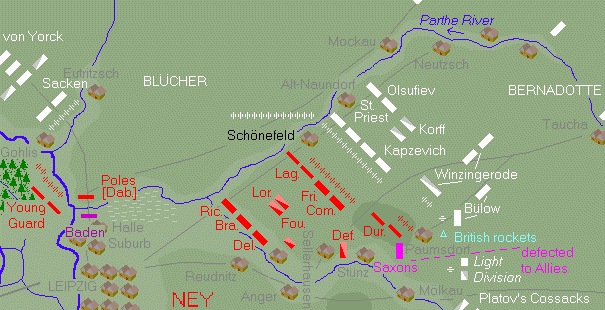|
"We seem to have reached the crisis;
now all depends on fighting hard."
- Napoleon, 12th October 1813
|

The Battle of Leipzig, 16th October (southern front)
"The decisive hour has now arrived for France.
This evening we must either win or all die !"
- French General Maison to his young soldiers
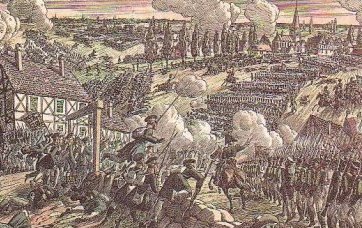 The day of Oct 16th was dark and rainy.
The day of Oct 16th was dark and rainy.
The first shots were exchanged about 8 am near Wachau. It was the signal given by the Allies and immediately afterward the artillery on both
sides opened fire. Marbot writes: "On the 16th of October at 8 o'clock in the morning,
the allied batteries gave the signal for the attack. A lively cannonade was directed at
our lines and the allied army marched towards us from every point."
About 9 am the Young Guard arrived and began deploying behind Liebertwolkwitz.
A coach escorted by Guard chasseurs arrived. Napoleon dismounted and joined Murat
already standing on a height and surveying the battlefield. The troops greeted him with a
yell that must have been heard for miles around. The Emperor bent over his maps in silence while the generals looked on, their hats under their arms. Napoleon could see many Allies columns
arriving and deploying in their assigned positions. It was already one hour since the enemy
was in motion. Their staff officers galloped fine horses between the various troops.
 Barclay de Tolly had a direct command over the Allies between Pleisse River and Gross-Posna.
It was the main force of Schwarzenberg's massive army. Mikhail Bogdanovich Barclay de Tolly
(1761-1818) was one of the most talented Russian and Allies'
commanders. He was raised in the Baltic province of Livonia which then belonged to Russia (now is part of
Estonia and Latvia). De Tolly was a German-speaking descendant of a Scottish family which had settled in
Livonia in the 17th Century.
He commanded the right flank at Borodino with great valor and presence of mind.
After Kutuzov's death, he once again became commander-in-chief of the Russian forces.
In 1814 Barclay de Tolly led the taking of Paris, receiving the
baton of a field marshal in reward.
Barclay de Tolly had a direct command over the Allies between Pleisse River and Gross-Posna.
It was the main force of Schwarzenberg's massive army. Mikhail Bogdanovich Barclay de Tolly
(1761-1818) was one of the most talented Russian and Allies'
commanders. He was raised in the Baltic province of Livonia which then belonged to Russia (now is part of
Estonia and Latvia). De Tolly was a German-speaking descendant of a Scottish family which had settled in
Livonia in the 17th Century.
He commanded the right flank at Borodino with great valor and presence of mind.
After Kutuzov's death, he once again became commander-in-chief of the Russian forces.
In 1814 Barclay de Tolly led the taking of Paris, receiving the
baton of a field marshal in reward.
At Leipzig de Tolly commanded two large battle groups (Klenau's and Wittgenstein's)
see map ^
30,000 men under Klenau, this goup attacked Liebertwolkwitz
Klenau's own [Austrian] IV Corps had 24,500 men and Ziethen's [Prussian] 11th Brigade had
5.360 men.
38,000 men under Wittgenstein attacked Liebertwolkwitz, Wachau and Mark-kleeberg
- against Liebertwolkwitz advanced Mesenzov's [Russian] 5th Division, and Pirch's [Prussian]
10th Brigade. All troops were under Gorchakov.
- against Wachau advanced Prinz Eugen's [Russian] II Infantry Corps, Klux's [Prussian]
9th Brigade, and 4 btns. of von Preussen's [Prussian] 12th Brigade under Schwiczow.
All troops were under Prinz Eugen.
- against Mark-kleeberg advanced Helfreich's [Russian] 14th Division, von Preussen's
[Prussian] 12th Brigade, and 3 btns. of [Prussian] 9th Brigade. All troops were under Kleist.
- between the infantry advancing on Liebertwolkwitz and Wachau was Pahlen's [Russian] Cavalry Corps,
and between the infantry marching on Wachau and Mark-kleeberg was Levashov's [Russian] Cuirassier Brigade,
and a hussar regiment.
Fight along the Pleisse River.
Struggle for the villages of Connewitz, Dolitz and Mark-kleeberg.
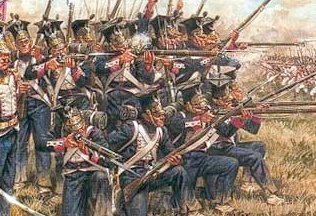 Four strong Austrian infantry regiments moved against Connewitz and Dolitz on the Pleisse River:
Four strong Austrian infantry regiments moved against Connewitz and Dolitz on the Pleisse River:
- 44th Bellegarde Regiment of Lederer's Division
- 24th Strauch Regiment of Lederer's Division
- 56th W. Colloredo Regiment of Liechtenstein's Division
- 20th Kaunitz Regiment of Liechtenstein's Division
All four units were part of Merveldt's II Corps.
The Austrians marched to Gautsch and then eastwards on Connewitz and Dolitz.
French battery covered the approach to Connewitz and the houses were occupied by skirmishers
of Lefol's Division. The Austrians could only advance on a narrow front and their
attack was easily repulsed. The terrain was so difficult that they were unable to bring their own artillery.
The Austrians therefore looked for alternative crossing point. They pulled back and kept the
French only under long range musket fire.
The Austrians moved against Dolitz. The manor house was defended by a small Polish garrison
but the bridges were intact. Two companies of 24th Strauch Regiment threw the defenders out
and back over the river. The Poles rallied and counter-attacked, they retook the gatehouse at bayonet point.
The Austrians attempted to recover the gatehouse but their Colonel Reisenfels was mortally wounded
and they fell back. Digby-Smith writes: "The combat was so hot that the Reegiment Strauch was soon
out of ammunition, and was replaced by three companies of Regiment Kaunitz 20th ..."
Austrian General Bubna described the scene: "The French [Polish] resistance here had been desperate; their bodies
lay thickly in the rubble of the houses in the roads and among the barricades of the bridge. ...
Many, many of our comrades had shed their blood here. The wood was full of our dead and on the bank of the Pleisse there
were thick rows of our men who had died in a musket fire at 12 paces."
At 3 PM the Austrians brough their artillery up to the manor and the mill on the east bank
was afire. The Poles had to abandon the burning building. Justice Kurth writes: "The retreating Poles set fire to several farms
and houses in the area with bundles of blazing straw."
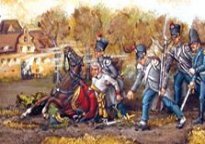 Commander of the Austrian troops fighting along the Pleisse, Merveldt, was extremely short-sighted and mistook some of the enemy troops over the Pleisse for Prussians.
He ordered a bridge to be thrown over the river and rode over it with few ADCs. His horse was soon killed
and Merveldt was captured by the Polish grenadiers (of Curial's 2nd Old Guard Division).
The Poles and Frenchmen found a copy of the Allied plan in his pocket and delivered it to Napoleon.
Commander of the Austrian troops fighting along the Pleisse, Merveldt, was extremely short-sighted and mistook some of the enemy troops over the Pleisse for Prussians.
He ordered a bridge to be thrown over the river and rode over it with few ADCs. His horse was soon killed
and Merveldt was captured by the Polish grenadiers (of Curial's 2nd Old Guard Division).
The Poles and Frenchmen found a copy of the Allied plan in his pocket and delivered it to Napoleon.
.
 According to George Nafziger due to the "accidents of the terrain" the village of Mark-kleeberg was an important point
in Napoleon's defenses. Napoleon ordered Poniatowski and Augereau (on map
P and A) to defend this area. Poniatowski saddled his mount early in the morning and after hearing the crackle of
musketry rode south. Kleist's troops marched from Crostewitz to Mark-Kleeberg and along
the Pleisse River.
According to George Nafziger due to the "accidents of the terrain" the village of Mark-kleeberg was an important point
in Napoleon's defenses. Napoleon ordered Poniatowski and Augereau (on map
P and A) to defend this area. Poniatowski saddled his mount early in the morning and after hearing the crackle of
musketry rode south. Kleist's troops marched from Crostewitz to Mark-Kleeberg and along
the Pleisse River.
One Austrian battalion took possesion of the unoccupied manor house. They also repaired the school
bridge and took position in the school. Marshal Augereau ordered one brigade of the 51st Division to retake the school.
The French advanced with sappers in their lead who used heavy axes to smash through the
school's door. The Austrians were thrown out of the building and back over the river.
The French and some Poles attempted to attack the manor but the gate-house formed an excellent defensive position.
The casualties mounted and Poniatowski seeing that there was no serious threat from this quarter
withdrew the assaulting troops.
From the south the first wave of attackers was made of 3 btns. led by Löbel. On their
flank marched marched Helfreich's Russian 14th Infantry Division. Allies artillery (60 guns)
cannonaded the Polish and French infantry and Löbel's force pushed back French infantry but were halted by
ravine and well-directed musket fire of Polish infantry. Helfreich's 14th Division (8 tbns.) arrived.
Struck in flank by Russians, the Poles (6 btns.) fell back and Löbel (3 btns.) entered
Mark-kleebrg. Poniatowski halted his retiring infantry and said words of
encouragement. He then deployed 6 battalions into a thick skirmish line. Helfreich
also deployed part of his infantry into skirmish chain but his further advance was stalled.
The fighting settled down to musket fire and long-range artillery bombardement.
Because Helfreich became engaged against Poniatowski it created a gap between him and
Allies advancing against the village of Wachau. Kleist directed Schwichow with 4 btns.
(2 infantry and 2 Landwehr) from the 12th Brigade to close the gap.
The French cannonaded the 12th Brigade and Schwichow's detachment and charged them
with cavalry. Because the Prussians were caught in open field their casualties mounted with
every minute. Levashov (8 sq. of cuirassiers) and Davidov (4 sq. of hussars) made several charges
and threw back the French cavalry. Davidov fought with great bravery.
Poniatowski recaptured Mark-kleeberg but Prussian 2 btns. counter-attacked and retook it.
The French and Poles were driven back but not defeated and General Kleist called urgently
for support. His superiors, Wittgenstein and Barclay de Tolly had their troops already assigned
to certain tasks and were about to enter their own combat near Wachau and Liebertwolkwitz. So the aid was to come from
the Austrians.
 The Austrians were brought in and deployed in front of Mark-kleeberg.
The fresh large force had no great difficulties in retaking the village.
Though the ranks of Poniatowski's infantry were thinned, their determination was strong.
As they passed through the gardens and into an open field, they let forth a savage yell
and furiously pressed forward. Allies guns cut bloody swaths through their formation and
soon added volleys of musketry - but the attackers kept on, and retook the village at bayonet
point. Large groups of white-clads were seen fleeing from Mark-kleeberg.
The Austrians were brought in and deployed in front of Mark-kleeberg.
The fresh large force had no great difficulties in retaking the village.
Though the ranks of Poniatowski's infantry were thinned, their determination was strong.
As they passed through the gardens and into an open field, they let forth a savage yell
and furiously pressed forward. Allies guns cut bloody swaths through their formation and
soon added volleys of musketry - but the attackers kept on, and retook the village at bayonet
point. Large groups of white-clads were seen fleeing from Mark-kleeberg.
The Austrians responded with directing their grenadiers against the Poles. It was the
Grenadier Division led by Feldmarschall-Leutenant Nikolaus von Weissenwolf,
elite force and flower of the Austrian infantry. The grenadiers were large men and wore impressive
tall fur caps. They swiftly moved into the woods by Pleisse River and attacked from the flank
and rear forcing the Poles to abandon the village. But here and there some Polish die-hards
still kept it fighting, reloading their weapons or swinging their weapons like clubs before
being overcome by the more numerous enemy. Poniatowski's Poles and Augereau's Frenchmen were also attacked along the
Pleisse River.
Attack on Wachau.
Areas had to be taken street by street
and building by building.
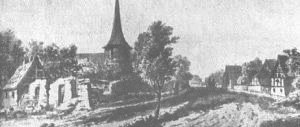 Russian II Infantry Corps (3rd & 4th Division, total of 5.200 men only) under Eugene passed by
Gulden Gossa and continued north against Wachau. Prinz Eugene formed advance guard, 3 btns. led by Reibnitz
while the Prussians added their 2 btns. drawn from 9th Brigade. These forces were about to attack Napoleon's center.
When Eugene arrived in front of Wachau he deployed 48 guns and directed Reibnitz to capture
the village. It was a small force but Eugene didn't expect much trouble, the village seemed
only lightly garrissoned. Eugene formed his 3rd Division in two lines of battalions.
Behind the 3rd stood the 4th Division. To the right and rear of Eugene's infantry marched
GL Pahlen's 2.600 hussars, uhlans and Cossacks.
Russian II Infantry Corps (3rd & 4th Division, total of 5.200 men only) under Eugene passed by
Gulden Gossa and continued north against Wachau. Prinz Eugene formed advance guard, 3 btns. led by Reibnitz
while the Prussians added their 2 btns. drawn from 9th Brigade. These forces were about to attack Napoleon's center.
When Eugene arrived in front of Wachau he deployed 48 guns and directed Reibnitz to capture
the village. It was a small force but Eugene didn't expect much trouble, the village seemed
only lightly garrissoned. Eugene formed his 3rd Division in two lines of battalions.
Behind the 3rd stood the 4th Division. To the right and rear of Eugene's infantry marched
GL Pahlen's 2.600 hussars, uhlans and Cossacks.
The Prussians followed the Russians. Their 9th Brigade (5.800 men) under GM von Klüx
was in reserve behind Eugene's infantry, and also was formed in two lines of battalions.
When the fighting began the Prussians moved to the front and fought side by side with the Russians.
The Russian and Prussian artillery opened fire on the French in and around Wachau.
Ob. Reibnitz's advance guard (3 Russian in first line and 2 Prussian btns. in the second)
was the first to attack.
The first shots were fired from the flank, from the direction of the Hearth Wood.
Reibnitz slightly changed the direction of his advance leading his troops against the wood.
The French were in Wachau and once they saw Reibnitz exposing his
flank they attacked and mauled the Russians.
 Two Prussian battalions were behind Reibnitz and now they were drawn into the fight.
The Prussians blasted their way towards the village's center. But the French were not push-overs.
Areas had to be taken street by street and building by building. The Prussians brought
von Schwichow's 3-4 btns. to stabilize their gains in
Wachau but the French artillery fired into their flank forcing them to a hasty withdrawal.
The French infantry pursued them but found themselves under fire from Prussian battery
and skirmishers. The French fell back to Wachau.
Two Prussian battalions were behind Reibnitz and now they were drawn into the fight.
The Prussians blasted their way towards the village's center. But the French were not push-overs.
Areas had to be taken street by street and building by building. The Prussians brought
von Schwichow's 3-4 btns. to stabilize their gains in
Wachau but the French artillery fired into their flank forcing them to a hasty withdrawal.
The French infantry pursued them but found themselves under fire from Prussian battery
and skirmishers. The French fell back to Wachau.
The result of first attack on Wachau was such that the French still held the entire village
while the Prussians kept the small wood. (Some sources give only one Prussian btn.
in the Hearth Wood, while others claim that there were 2 Prussian and 1 weak Russian btn.)
Attack on Liebertwolkwitz.
The Austrians run over the barricades
and down the streets, with their drummers
beating a ragged advance.
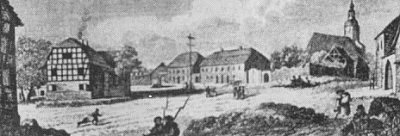 Liebertwolkwitz was a big village and dominated the surrounding area.
It was defended by Lauriston's V Army Corps. John Elting writes about
Jacques Alexandre Bernard Law, marquis de Lauriston: "born in India
of a Scots refugee family, (ext.link) a polished gentleman and the artillery
expert among Napoleon's aides-de-camp..." Against Lauriston (13.200 men) marched Mesenzov's Russian 5th Division (5.000 men) and Pirch's Prussian 10th Brigade (4.550 men).
Graf Klenau's Austrian IV Corps (24.500 men) and Ziethen's Prussian 11th Brigade (5.360 men) moved against Lauriston and Macdonald (18.000 men).
Liebertwolkwitz was a big village and dominated the surrounding area.
It was defended by Lauriston's V Army Corps. John Elting writes about
Jacques Alexandre Bernard Law, marquis de Lauriston: "born in India
of a Scots refugee family, (ext.link) a polished gentleman and the artillery
expert among Napoleon's aides-de-camp..." Against Lauriston (13.200 men) marched Mesenzov's Russian 5th Division (5.000 men) and Pirch's Prussian 10th Brigade (4.550 men).
Graf Klenau's Austrian IV Corps (24.500 men) and Ziethen's Prussian 11th Brigade (5.360 men) moved against Lauriston and Macdonald (18.000 men).
Mesenzov left the safety of University Wood and marched on Liebertwolkwitz.
The French artillery opened fire and forced him back. Mesenzov then was placed between
University Wood and Gulden Gossa. In Gulden Gossa were 3 btns. of 10th Brigade and a
Russian battery. The rest of the Prussian brigade stood behind that village.
 As already mentioned above Liebertwolkwitz was defended by part of Lauriston's V Army Corps. Almost all rank-and-file were young men. They were led by seasoned NCOs and officers.
Lauriston also had 50 guns served by excellent gunners, and three companies of engineers.
The artillery was deployed on both sides of the village.
As already mentioned above Liebertwolkwitz was defended by part of Lauriston's V Army Corps. Almost all rank-and-file were young men. They were led by seasoned NCOs and officers.
Lauriston also had 50 guns served by excellent gunners, and three companies of engineers.
The artillery was deployed on both sides of the village.
The first to storm Liebertwolkwitz were the Austrians.
In the first line was Archduke Charles Regiment (1.805 men), in the second were
4 btns. and in reserve was cavalry. The south-east part of Liebertwolkwitz
was defended by Maison's 16th Division (3.700 men). Maison detached 1 btn. to defend the cemetery.
The French levelled their muskets over the garden walls and furniture barricades and fired.
Despite hail of bullets the white-coats entered the village, run over the barricades and
down the streets, with their drummers beating a ragged advance.
By the church stood group of French infantry, they lifted their muskets and fired.
The attackers halted. Yet more white coats were coming and penetrating the other streets.
After a prolonged street fighting the French were pushed out of Liebertwolkwitz.
The casualties on both sides were heavy, with Austrian GM Mohr and GM Splenyi being wounded.
The victors began to dismantle the barricades built by the French.
Digby-Smith writes: "Despite stiff resistance, Mohr succeeded in taking most of the village,
the Austrians pushing as far as the church in a fierce house-to-house fight amidst
the burn-out ruins. This success was short-lived, hovewer. French reinforcements from Charpentier's 36th Division (the 14th Legere)
were poured in and the Austrians were ejected. It was eleven o'clock."
Napoleon strikes back.
The Emperor ordered to retake the villages
and break enemy's line.
 Napoleon stood on a hill behind Wachau until 3 pm. He discovered that the Allies had seized the initiative.
Their disorderly, piecemeal advance offered an ideal target for a counterattack,
but Macdonald and Sebastiani had not yet come up. Without them, Napoleon could only fight
a defensive-offensive battle, moving Augereau's corps and the Young Guard to back up the
weakest parts of his line. The Emperor ordered to recapture the villages, pushed the enemy
back and expose to artillery fire. Then break enemy's line by massive cavalry and infantry attack.
Napoleon stood on a hill behind Wachau until 3 pm. He discovered that the Allies had seized the initiative.
Their disorderly, piecemeal advance offered an ideal target for a counterattack,
but Macdonald and Sebastiani had not yet come up. Without them, Napoleon could only fight
a defensive-offensive battle, moving Augereau's corps and the Young Guard to back up the
weakest parts of his line. The Emperor ordered to recapture the villages, pushed the enemy
back and expose to artillery fire. Then break enemy's line by massive cavalry and infantry attack.
The Allies' commanders watching from a hill southwest of Gulden Gossa, noted how mutually
isolated their advancing columns were. Accordingly, they shifted the Russian guards,
grenadiers and cuirassiers to Magdeborn and Gulden-Gossa, and urged Schwarzenberg to send
the Austrian grenadiers and cuirassiers to support them.
Napoleon's formation was as follow:
Napoleon had also organized a massive battery on the Gallows Hill (almost 100 guns) with
the purpose to make a breakthrough in Allies line. If properly handled the artillery
eclipsed all other arms for sheer destructive capacity. The positioning of artillery was
of the utmost importance. The Gallows Hill was a slightly heightened area, hard and open
field. The natural strength of the high ground was augmented by clear fields of fire, and
good roads in the rear for the movement of supplies and troops. The artillery fire was a
recursor to the main attack against a selected point of the enemies line, in order to batter a breach
into which the main infantry and cavalry attack could plunge into.
"The Monk" and his 100 guns raised hell !
"The death came from the Gallows Hill."
 The overall command over the Grand Battery had Antoine Count
Drouot. He was arguably the best (after Napoleon) artillery general in Europe.
Not only as a gunner he was to admire. Napoleon wrote:
"His morals, his integrity, his lack of affectation, would have brought him honor in the
greatest days of the Roman Republic." Drouot was a very religious person and always
carried the bible, even in battles. For this he was nicknamed The Monk or The Sage of the Army.
Now this man and his 100 cannons will raise hell; kill and wound thousands of men and animals.
The overall command over the Grand Battery had Antoine Count
Drouot. He was arguably the best (after Napoleon) artillery general in Europe.
Not only as a gunner he was to admire. Napoleon wrote:
"His morals, his integrity, his lack of affectation, would have brought him honor in the
greatest days of the Roman Republic." Drouot was a very religious person and always
carried the bible, even in battles. For this he was nicknamed The Monk or The Sage of the Army.
Now this man and his 100 cannons will raise hell; kill and wound thousands of men and animals.
Meanwhile the Russians and Prussians increased their artillery facing the Grand Battery
from 24 to 52 guns but it was not enough against 100 French guns.
Drouot's artillery dismounted 24 Allies pieces while the remaining guns
hastily fell back and onto the road to Gulden-Gossa. Those Russian and Prussian gunners who had no riding place on the cannons or limbers were
running down the verges in hasty retreat. Once the artillery was gone Eugene's Russian II
Infantry Corps (3rd & 4th Division) became the only target for Drouot's gunners.
Digby-Smith writes: "The situation of the Russians on Klux's right, in the open fields ... was much worse.
Lacking any cover at all, they suffered very heavy losses from artillery fire. Shahovskoi ... reported to Prinz Eugen that his men were being destroyed.
The prince rode slowly along the line. At each battalion, his question 'How many men have you lost ?'
would be answered with a silent gesture to the lines of dead lying where they had fallen. ...
[Prinz Eugen] did nothing to alleviate the situation ... It was Borodino all over again (where Prinz Eugen had commanded the 4th
Infantry Division); the Russian commanders had learned nothing and continued to squander their men to absolutely no avail ..."
(Digby-Smith, - p 86)
A Russian officer was greatly impressed with the insane bravery of the prince, he wrote: "We saw him [Prinz Eugen]
... blind and deaf to the dangers, death and terrors around him, with his slim pale face
framed by his dark brown locks riding like an angel of death through the ranks."
Then a French cannonball went through the prince's horse and thrown the rider to the ground.
(When after battle Prinz Eugen handed his casualty list to Barclay de Tolly, the latter at first refused to believe
what he read ! Eugen retorted: "If Your Excellency refuses to acknowledge the deeds of those still
left alive, then perhaps a look at the dead on the battlefield where we fought will convince
you !")
The 3rd Division have suffered horrible casualties and was finally withdrawn towards Gulden-Gossa.
The 4th Division also got under fire and fell back on Crobern. The withdrawal was covered
by 6 Russian btns. who - meanwhile - had repulsed attack of French infantry from Wachau.
Drouot's battery also forced Mesenzov's Russian 5th Division to fall back. These Russians were
lurking from the University Wood and were planning to attack Liebertwolkwitz.
Pahlen's cavalry and Cossacks also got their share of projectiles and were obliged to withdraw.
With the Russians falling back Klux's Prussian 9th Brigade formed the front line.
The Prussians stood on the sunken road south of Wachau, in contrast to the Russians who
were in the open and took the lion's share of casualties from artillery fire.
Prussian 2 btns. were still in the Hearth Wood. But when Victor's infantry attacked, Klux
quickly fell back on Gulden-Gossa.
 The fire from the 100 guns was terrific. The fields were covered with smoke. Drouot
made a gap in enemy's line; three Russian infantry divisions, two Prussian brigades and Russian
cavalry corps were forced into a hasty withdrawal. The situation was ripe for a massive attack,
breaking the enemy's line and winning the battle. The cannons were firing on all cylinders
until Murat's 10,000 cavalrymen began to advance. Then they fell silent as the advancing masses obscured the line of fire.
The fire from the 100 guns was terrific. The fields were covered with smoke. Drouot
made a gap in enemy's line; three Russian infantry divisions, two Prussian brigades and Russian
cavalry corps were forced into a hasty withdrawal. The situation was ripe for a massive attack,
breaking the enemy's line and winning the battle. The cannons were firing on all cylinders
until Murat's 10,000 cavalrymen began to advance. Then they fell silent as the advancing masses obscured the line of fire.
Once the cavalry passed Napoleon ordered Drouot "The Monk" to take part of his Grand Battery
and push it forward. Marbot writes: "General Drout with 60 cannons aided the attack."
The crews manhandled the pieces back to hook them on to their limbers.
The ammunition wagons set off with their wheels digging great gouges into the
meadow. The guns rolled forward, with their chains and buckets swinging.
Grand Charge of Murat's 10,000 Cavalrymen.
Murat and his brave cavalry arrived
at a short distance from where Alies monarchs stood.
The emperors, kings and princes were in danger.
 Before the grand cavalry charge began, General Pajol sent his adjutant towards Gulden Gossa
"Please have a look at the valley before Gulden Gossa." The adjutant returned, reporting "Not goodd ... these horses are sinking to their
breasts." Pajol informed Murat and the two talked for a while. Then Murat galloped away in
order to consult with Latour-Maubourg. In this moment a Russian grenade exploded under Pajol's horse,
throwing him into the air. His left arm and hips were damaged. "My poor Pajol ! The attack is off to a good start before it even
begins !" cried Murat. (Bleibreu - Die Volkerschlacht bei Leipzig" p 76)
Before the grand cavalry charge began, General Pajol sent his adjutant towards Gulden Gossa
"Please have a look at the valley before Gulden Gossa." The adjutant returned, reporting "Not goodd ... these horses are sinking to their
breasts." Pajol informed Murat and the two talked for a while. Then Murat galloped away in
order to consult with Latour-Maubourg. In this moment a Russian grenade exploded under Pajol's horse,
throwing him into the air. His left arm and hips were damaged. "My poor Pajol ! The attack is off to a good start before it even
begins !" cried Murat. (Bleibreu - Die Volkerschlacht bei Leipzig" p 76)
The moment of charge was so close. The exploding shells frightened the horses.
Murat had drawn his saber which he now waved above his head as a signal
for the cavalry to advance. The charge was sounded and 10.000 horsemen in 96-110 squadrons
slowly passed between Wachau and the artillery on Gallows Height.
Napoleon wrote: "The King of Naples (Murat) placed himself at the head of the cuirassiers
and marched on the enemy's cavalry to the left of Wachau, while the Polish horse and the
dragoons of the Guard charged to the right."
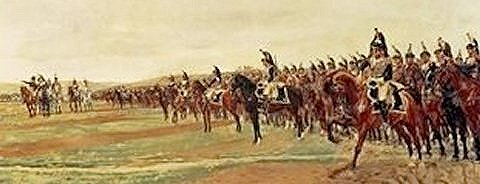 The mass of French, Italian and Saxon cavalry set off at a trot across the battlefield and then gradually sped up.
The front ranks boiled forward, hooves drummed up chunks of soil.
The mass of French, Italian and Saxon cavalry set off at a trot across the battlefield and then gradually sped up.
The front ranks boiled forward, hooves drummed up chunks of soil.
According to G.R.Gleig Murat formed all his cavalry "into one line of continuous columns of
regiments ... either because he desired to make a great show, or that he held in contempt the weak force which he presumed to face him,
he neglected to arrange any reserve." (Gleig - "The Leipsic Campaign" p 217)
Other sources described Murat's formation as follow: in the front Bordesoulle's 1st Heavy Cavalry Division,
behind was Doumerc's 3rd Heavy Cavalry Division, then Corbineau's 2nd Light Cavalry Division, next
Chastel's 3rd Light Cavalry Division. Berkheim's 1st Light Cavalry Division was detached and stood behind
Oudinot's Young Guard. It is not clear if Pajol's V Cavalry Corps participated in this charge or not.
About half of the sources say he did.
The French, Italians and Saxons rode in serried ranks kicking up dirt clouds in their wakes. Prussian and Russian skirmishers fled the Murat's sabers like mice fleeing a scourge of cats.
Only few stopped to fire at their pursuers, but they dared not pause long for fear
of the sabers. The Russian and Prussian cannons sprayed them with canister tearing through
flesh and ricocheting off their iron breastplates.
On Murat's path was Eugene's Russian II Infantry Corps. His battalions were only 100-200 men
strong and when they formed squares they were so small that there was no place for senior
officers and for the wounded inside them. The tiny squares blasted the French with musket
volleys so that the horsemen milled about in confusion, men and horses dropping.
It is impossible too highly to admire the devotion and the absence of all sense of danger,
on the part of the French officers. They pressed on, led by example and one squares was
broken. Approx. 60 men were taken prisoner. The thrusting, hacking and slashing of their
sabers drove the Russian and Prussian gunners back. While the French cuirassiers broke infantry square,
the Saxon cuirassiers captured 24 Russian guns. The French cuirassiers and some hussars arrived at a short distance from where Alies monarchs stood.
Schwarzenberg was anxious about the safety of the Tsar of Russia and King of Prussia and asked
them to leave.
The Tsar refused.
Uhlans vs Cuirassiers.
Great cavalry battle with 14 regiments involved.
 During Napoleon's offensive in the center, there were simultaneously fought two cavalry
battles on both flanks. On the eastern flank fought Sebastani's II Cavalry Corps with
Prussian cuirassiers (with no armor) and Austrian light cavalry. On the western flank,
Sokolnicki's (Polish) IV Cavalry Corps faced Austrian Cuirassier Corps led by Nostitz
and Russian cuirassier brigade.
During Napoleon's offensive in the center, there were simultaneously fought two cavalry
battles on both flanks. On the eastern flank fought Sebastani's II Cavalry Corps with
Prussian cuirassiers (with no armor) and Austrian light cavalry. On the western flank,
Sokolnicki's (Polish) IV Cavalry Corps faced Austrian Cuirassier Corps led by Nostitz
and Russian cuirassier brigade.
Officially the IV Cavalry Corps was under the famous cavalry commander
Kellermann, but this general was not doing well on that day. Thus the Poles were led by one of their own,
Michal Sokolnicki (1760-1816), one of the top Polish generals.
Sokolnicki had only four (Polish) regiments: 1st Chasseurs armed with lances, and
3rd, 6th and 8th Uhlans. The Poles waited impatiently for charge, with their horses trampling
the grass and tossing their heads. All four units were led by excellent colonels and senior officers.
"They (Poles) made up for its lack of numbers with equestrian skill and aggressive nature." (- George Nafziger)
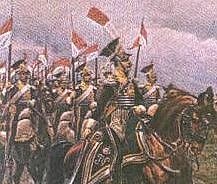 Firstly, Sokolnicki directed the 1st Chasseurs against Russian 14th Infantry Division and two
Prussian batteries. The chassseurs came down and broke one infantry square in the instant
and took 600 prisoners. They attempted to reform but were hit from the rear by entire
Russian cuirassier brigade led by GM Levashov. The chasseurs were forced to abandon their
prisoners, fired few shots and fled. The Russian heavies pursued them shortly
before being attacked by 3rd Uhlans. The uhlans spurred forward and the whole front rank swung their lances' points down into
the charge. They strucked the iron-clad cuirassiers "in both flanks" and immediately
threw them back. The lances were drawn back and thrust forward into unprotected arms, necks
and faces of the cuirassiers. The cuirassiers were saved from destruction by Russian Loubny
Hussar Regiment.
Firstly, Sokolnicki directed the 1st Chasseurs against Russian 14th Infantry Division and two
Prussian batteries. The chassseurs came down and broke one infantry square in the instant
and took 600 prisoners. They attempted to reform but were hit from the rear by entire
Russian cuirassier brigade led by GM Levashov. The chasseurs were forced to abandon their
prisoners, fired few shots and fled. The Russian heavies pursued them shortly
before being attacked by 3rd Uhlans. The uhlans spurred forward and the whole front rank swung their lances' points down into
the charge. They strucked the iron-clad cuirassiers "in both flanks" and immediately
threw them back. The lances were drawn back and thrust forward into unprotected arms, necks
and faces of the cuirassiers. The cuirassiers were saved from destruction by Russian Loubny
Hussar Regiment.
One company of Polish grenadiers was sent in support for the chasseurs.
The Russian cuirassiers saw the isolated infantry troop, surrounded and killed to the
last man. There was no love lost between the strongly pro-napoleonic Poles and the
Russians.
The 6th and 8th Uhlans arrived and avenged their comrades by routing the mass of
cuirassiers and throwing them back on hussars. Within next one hour Sokolnicki's cavalry will
execute seven charges.
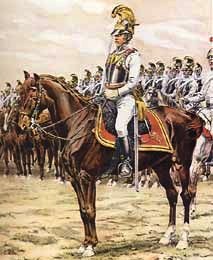 Meanwhile the powerful Austrian Cuirassier Corps led by Nostitz crossed Pleisse River by Gautzsch and
advanced toward Auenhain sheep-farm. The six fresh cuirassier regiments were far too much for
the exhausted Poles and Napoleon sent
Old Guard dragoons led by the famous General Letort to support them.
The Poles and Old Guard dragoons executed several spirited charges against the cuirassiers,
and even the uhlans reached as far as Crobern ! Allies' infantry and gunners in and around this village
fled in horror, splashing through the river and ran past Crobern. Meanwhile 3rd Uhlans
and French battery were attacked by two Austrian cuirassier regiments (Albert & Lothringen).
The cuirassiers wore voluminous greatcoats over armor and the Poles mistook them for
armorless dragoons. Unpleasantly surprised they fled until the 1st Chasseurs and Old Guard
dragoons rescued them. The Poles and French could do nothing when newly arrived regiments
(Erzherzog Franz and Kronprinz Ferdinand) attacked them. The enemy had 9 regiments (8 cuirassiers and 1 hussars)
against 5 Polish and French (3 uhlans, 1 chasseurs and 1 Old Guard dragoons). Sokolnicki's cavalry retired behind
Poniatowski's infantry, and the dragoons behind Wachau.
Meanwhile the powerful Austrian Cuirassier Corps led by Nostitz crossed Pleisse River by Gautzsch and
advanced toward Auenhain sheep-farm. The six fresh cuirassier regiments were far too much for
the exhausted Poles and Napoleon sent
Old Guard dragoons led by the famous General Letort to support them.
The Poles and Old Guard dragoons executed several spirited charges against the cuirassiers,
and even the uhlans reached as far as Crobern ! Allies' infantry and gunners in and around this village
fled in horror, splashing through the river and ran past Crobern. Meanwhile 3rd Uhlans
and French battery were attacked by two Austrian cuirassier regiments (Albert & Lothringen).
The cuirassiers wore voluminous greatcoats over armor and the Poles mistook them for
armorless dragoons. Unpleasantly surprised they fled until the 1st Chasseurs and Old Guard
dragoons rescued them. The Poles and French could do nothing when newly arrived regiments
(Erzherzog Franz and Kronprinz Ferdinand) attacked them. The enemy had 9 regiments (8 cuirassiers and 1 hussars)
against 5 Polish and French (3 uhlans, 1 chasseurs and 1 Old Guard dragoons). Sokolnicki's cavalry retired behind
Poniatowski's infantry, and the dragoons behind Wachau.
Sommariva Cuirassiers went into action against Berkheim's French lancers. The lancers broke and
fled closely followed by the Austrians. A Saxon officer recalled the event as follow: "When we [Saxon cuirassiers] reached Berckheim, his men were mixed up with the enemy
in individual squadrons, so that there were Austrian units to the north of the French lancers. We Saxons had only just come up wwhen Berckheim rallied his men to face
the ever-increasing enemy pressure. But they could not stand even though Berckheim - bareheaded, as his hat
had been knocked off - threw himself into the thick of the melee.
He was also swept back in the flood of fugitives ... Despite this chaos, we stood fast and hacked away
at the Austrians. Shortly before they charged us, the Austrians had shouted to us to come over to them; we ignored them.
However, we were overpowered and broken. The chase now went on at speed, friend and foe all mixed up together, racing over the plain."
On the eastern flank Sebastiani's French II Cavalry Corps (2 horse carabinier, 4 cuirassier, 3 lancer,
7 chasseur, and 3 hussar regiments) fought well until Platov's Cossacks arrived.
Cossacks' appearance on the flank caused Sebastiani to pull back. Matvei Ivanovich Platov slowly followed the enemy.
The Young Guard in action.
"... drive away these guys [Russians and Prussians]
with a kick in the rear ..."
- Oudinot to Young Guard
 Lauriston's V Corps and Victor's II Corps recaptured both villages, Liebertwolkwitz and Wachau.
Now the Young Guard strirred by the rhytmic beating of its drums, passed them and moved against Allies' lines.
Lauriston and Victor followed them.
Lauriston's V Corps and Victor's II Corps recaptured both villages, Liebertwolkwitz and Wachau.
Now the Young Guard strirred by the rhytmic beating of its drums, passed them and moved against Allies' lines.
Lauriston and Victor followed them.
Marshal Oudinot led the I Infantry Corps of the Young Guard (24 voltigeur battalions). He was celebrated as the most
wounded marshal, very brave in combat, a soldier's marshal. Nicolas-Charles Oudinot, Duke of
Reggio (1767-1847) was not, and made no pretence of being, a great commander, he led by example from the
front rank, like Roman centurion. (ext.link)
Now, at Leipzig, Oudinot turned to his generals and said: "Take your division Decouz, and that of Pacthod
and drive away these guys with a kick in the rear, so that they then will only flee."
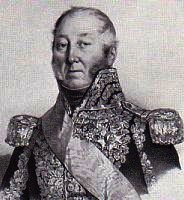 The big-man Marshal Mortier led the II Infantry Corps of the Young Guard (20 tirailleur and 4 flanquer battalions).
Édouard-Adolphe-Casimir-Joseph Mortier, duc de Trévise was a seasoned campaigner, reliable man and brave leader.
The big-man Marshal Mortier led the II Infantry Corps of the Young Guard (20 tirailleur and 4 flanquer battalions).
Édouard-Adolphe-Casimir-Joseph Mortier, duc de Trévise was a seasoned campaigner, reliable man and brave leader.
The Young Guard began their advance with the alacrity of brave men advancing to assured victory.
Their snarling officers marched with drawn sabers. They cheered their Emperor as they marched past him. The drummers, tediously beating the
rhythm of the march, broke into flurries when they realized He was so close.
Napoleon and his staff watched their advance.
Oudinot's troops passed by Wachau and in frontal assault captured Auenhain sheep-farm. Mortier's troops drove into University Wood
sweeping all before them.
Victor's II Corps advanced "with great impettuosity" with Dubreton's division in its lead.
They marched on Gulden Gossa defended by 3 Prussian btns. and Russian battery. The attackers
drove the garrison back into the center of the village before a fresh Prussian btn.
counter-attacked and recaptured the lost ground.
The French brought their artillery and began "a tremendous barrage" against the village and its defenders.
Macdonald on the extreme eastern flank.
On the eastern flank Macdonald's XI Army Corps made of Italians, Germans and French initially pushed the Austrians
back. But about 4 pm Klenau aggressively counter-attacked and regained some of the lost
terrain. The battle here settled down to an artillery duel. Macdonald's four divisions led by
generals Ledru, Charpentier, Marchand and Gerard attacked again but without much success.
Allies' reaction to Napoleon's offensive.
Schwarzenberg became very troubled.
'Seeing the developments, Schwarzenberg standing on the heights south of Gulden Gossa
became very troubled. The Allies realizing the importance of Gulden-Gossa and Auenhain (sheep-farm) positions
sent forward everything they could mass against them.
Several Russian elite troops received instructions to advance forward and deploy south
of Gulden-Gossa. These were reserve troops of Grand Duke Constantine:
Raievski's III 'Grenadiers' Corps
Yermolov's V 'Guard' Corps
Prince Golitzin's Guard & Cuirassier Corps
At 4 pm, when the Russian Guards and grenadiers moved against Gulden Gossa,
the Austrian reserves marched against Auenhain. These troops were:
Grenadier Corps (led by Hessen-Homburg)
Cuirassier Corps (led by Nostitz)
A formidable artillery force, formed of 80 Russian guns, fired in support of the infantry.
Schwarzenberg, seconding Merveldt's attack, sent part of Bianchi's division between the Gosel
stream and the Pleisse, below Crostewitz. This movement, supported by Kleist, would take
Oudinot and Victor in the rear.
The Russian and Austrian grenadiers.
Raievski had ordered to counterattack - not firing a single
shot the Russian grenadiers drove the French back with their bayonets.
 Pisarev's Russian 1st Grenadier Division was moved forward and deployed south of Auenhain sheep-farm.
On each flank of the division was posted a single cuirassier regiment. The cuirassiers were
Levashov's brigade. Pisarev's grenadiers formed themselves in one line of battalion-squares
and waited. With the grenadiers and cuirassiers was General Raievski, the Hero of Borodino.
Pisarev's Russian 1st Grenadier Division was moved forward and deployed south of Auenhain sheep-farm.
On each flank of the division was posted a single cuirassier regiment. The cuirassiers were
Levashov's brigade. Pisarev's grenadiers formed themselves in one line of battalion-squares
and waited. With the grenadiers and cuirassiers was General Raievski, the Hero of Borodino.
Jolting up and down in the saddles, French cuirassiers of Latour-Maubourg's Cavalry Corps
arrived, some in compact formations while others in large groups. They attacked with fury
and dispersed the Russian cuirassiers. The grenadiers however held their ground, they
delivered a volley at close range and number of horses hit by the musketballs stumbled and
fell. Unhorsed Frenchmen stood up and angrily shook their swords in impotent fury
at those indomitable human walls. Only the bravest dared to penetrate between the squares.
The French guns unlimbered and fired canister at the grenadiers who stood "like a boulder in the
middle of the indignant mass." (Mikhailovski-Danilevskii "Denkwurdigkeiten aus dem
Feldzuge vom Jahre 1813"pp 239-240)
A French musketball shattered Raievski's shoulder. He removed it from his body and showed
to his officers reciting a verse: "I don't have anything more of the blood, that was given
me. This blood exhausted itself, spilled for the motherland."
It was his second wound, he had his head already bandaged after being wounded some
time earlier. Victor's young infantrymen attacked Raievski's grenadiers but without success.
In response Raievski had ordered to counterattack - not firing a single
shot these solemn warriors drove the French back with their bayonets. Victor's troops
rapidly fell back towards Wachau and Auenhain sheep-farm. When the grenadiers attepted to
capture the sheep-farm Dubreton's 4th Division repulsed them with musket fire (all the walls were loopholed.)
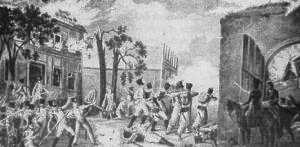 Before 4 pm the Austrian Grenadier Corps (Grenadier and Hungarian Division) crossed the
Pleisse River by Gauschwitz and Duben and marched to Crobern.
The Grenadier Division formed in battalion-masses moved towards Auenhain sheep-farm and
replaced Raievski's troops who returned to the reserves south of Gulden-Gossa.
One Austrian infantry btn. of Simbschen Regiment captured the sheep-farm but
Victor counter-attacked and retook it. The French strongly occupied the farm and
surroundings with infantry and artillery. They stood between Auenhain and Wachau, French and Polish
cavalry in the intervals between infantry columns.
Before 4 pm the Austrian Grenadier Corps (Grenadier and Hungarian Division) crossed the
Pleisse River by Gauschwitz and Duben and marched to Crobern.
The Grenadier Division formed in battalion-masses moved towards Auenhain sheep-farm and
replaced Raievski's troops who returned to the reserves south of Gulden-Gossa.
One Austrian infantry btn. of Simbschen Regiment captured the sheep-farm but
Victor counter-attacked and retook it. The French strongly occupied the farm and
surroundings with infantry and artillery. They stood between Auenhain and Wachau, French and Polish
cavalry in the intervals between infantry columns.
The Austrian grenadiers stormed the sheep-farm but Victor's infantry and artillery drove
them back. The grenadiers withdrew and reformed, then came back and overrun the guns.
The Hungarian Division and some grenadiers moved against Semele's 52nd Division
(of Augereau's IX Army Corps) and the French fell back behind Poniatowski's Poles.
Weissenwolf recorded the actin as follow: "I had the first battalions which came through Crobern advance [against Auenhain] at the charge.
At about 5 PM Oberst ressery with the 1st Battalion of Simschen, supported by my
[grenadier] battalions Call, Fischer, and Portner, made a second charge on Auenhain.
... Dressery overthrew the French infantry behind the farm and drove them back over the meadows but a counter-attack by their cavalry
forced him to form square quickly and to retire. Meanwhile, the Austrian grenadiers broke
into the sheep-farm, cut down or captured the garrison and recovered a colour which had been taken from the
Russians. They held the buildings through the night despite the fact that a French shell exploded an ammunition wagon
inside the courtyard and killed many of the garrison, which now consisted of the grenadier battalions Fischer and Portner ..."
Poniatowski brought up one battery and again formed his infantry in a thick skirmish line.
These troops halted the Austrians and Polish 1st Chasseurs charged and broke battalion of
Austrian infantry. Oudinot's Young Guard and part of Victor's infantry re-captured the
sheep-farm, pushing the Austrians out into the open. The Austrian grenadiers came back,
attacked and retook the sheep-pen buildings and the knoll to the east in one sweep.
The farm was partially destroyed.
Heroics of Maison's young soldiers.
"This evening we must either win or all die !"
- General Maiosn
 Part of Gulden-Gossa was captured by the French infantry before being lost to Prussian 2
btns. and Russian Lifeguard Jager Regiment. The guardsmen attacked with cold steel,
not a single shot was fired. They entered the streets formed in a narrow column and came
through the village like tornado. The Young Guard and Lauriston's infantry counter-attacked
but were charged with bayonet, thrown back and pursued. The Russian guardsmen passed by
Gulden-Gossa and advanced towards Auenhain sheep-farm.
Part of Gulden-Gossa was captured by the French infantry before being lost to Prussian 2
btns. and Russian Lifeguard Jager Regiment. The guardsmen attacked with cold steel,
not a single shot was fired. They entered the streets formed in a narrow column and came
through the village like tornado. The Young Guard and Lauriston's infantry counter-attacked
but were charged with bayonet, thrown back and pursued. The Russian guardsmen passed by
Gulden-Gossa and advanced towards Auenhain sheep-farm.
Meanwhile battery of more than 80 guns of Russian Guard and reserve artillery deployed on the height
south of Gulden-Gossa. The battery was commanded by General Suchozanet. The decimated Russian 3rd Division moved to the rear to give a
clear field of fire for the artillery. The 4th Division and Prussian 12th Brigade were
already behind Auenhain.
The guns were thundering as the blood-curdling French yells drew closer to Gulden Gossa.
It was the Young Guard and Maison's 16th Division attempting to take the village.
Maison had said to his soldiers: "The decisive hour has now arrived for France.
This evening we must either win or all die !" The young soldiers suffered badly from
artillery fire but held their ground until Russian 2nd Guard Division came and dislodged them.
The situation worsened for the French after 12 Russian horse guns opened fast fire on their
flank. Behind the guns was Pahlen's cavalry corps (uhlans, hussars and Cossacks).
Russian 2nd Cuirassier was deployed in front of Stormthal.
About 5 pm the French again attacked Gulden-Gossa. Maison's 16th Division fought particularly
well. They crossed bayonets with Russian guardsmen and were decimated by the artillery.
Several battalions of Prussian infantry and Russian grenadiers attacked them. The fighting was
ferocious, Maison was almost captured and barely escaped, and Raievski was wounded again.
Maison's soldiers were pushed back and the Allies' elite troops pursued them half way to Liebertwolkwitz.
After being decimated by powerful artillery and bayoneted by enemy's guardsmen Maison's die-hards
kept fighting on the next day.
In the University Wood.
In the University Wood the Allies counter-attacked several times and halted Mortier's Young
Guard but were unable to push him back. Mortier had two divisions, Barrois' and Roguet's made of
20 tirailleur and 4 flanquer battalions. There were also several battalions of Lauriston's corps.
After some hard fighting Mortier gained even more ground
until at 4 pm Russian 2nd Grenadier Division entered the Wood and joyfully picked up the fight
at close quarters with the French. The long fighting settled down to an artillery bombardement
and skirmishers sniping at each other.
French cuirassiers vs Russian guard cavalry and Prussians.
"They are going into fight as if they were coming to a wedding."
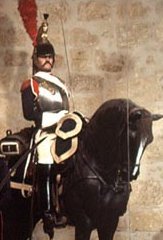 To halt the advance of Murat's cavalry the Allies unleashed their guard cavalry.
"General Shevich ... leading the dragoons, hussars and uhlans of the Russian Guard Light
Cavalry Division to the attack. Before they could form for the attack, the French struck
and crushed them, killing Shevich and Davidov of the Guard Hussars in the process."
(Nafziger - "Naapoleon at Leipzig" p 124)
The iron-clads mauled the Lifeguard Dragoons and Lifeguard Hussars but were halted by the
Lifeguard Uhlans. These uhlans were one of the favorite units of Grand Duke Constantine, Tsar's brother.
To halt the advance of Murat's cavalry the Allies unleashed their guard cavalry.
"General Shevich ... leading the dragoons, hussars and uhlans of the Russian Guard Light
Cavalry Division to the attack. Before they could form for the attack, the French struck
and crushed them, killing Shevich and Davidov of the Guard Hussars in the process."
(Nafziger - "Naapoleon at Leipzig" p 124)
The iron-clads mauled the Lifeguard Dragoons and Lifeguard Hussars but were halted by the
Lifeguard Uhlans. These uhlans were one of the favorite units of Grand Duke Constantine, Tsar's brother.
 Near Gulden-Gossa the Lifeguard Cossacks attacked the French cuirassiers from the front while
the Prussian Neumark dragoons and Silesian cuirassiers struck from the eastern flank.
Murat's cavalry was also hit with canister fire. It was too much for the French,
they were pushed back everywhere and pursued until the positions of Drouot's
batteries. The pursuers were halted only by artillery fire and counter-attack made by
Old Guard dragoons led by Letort.
Marbot explained why this happened: "This treatment resulted in the enemy centre yielding and it was about to
give way when the Tzar of Russia who had witnessed the disaster, rapidly advanced the
numerous cavalry of his Guard which, encountering the squadrons of Latour-Maubourg in the
state of confusion which always follows an all-out charge, repelled them in their turn and
took back 24 of the guns which they had just captured. It was during this charge that General
Latour-Maubourg had his leg carried away by a cannon-ball."
Tsar Alexander seeing the charge of the Lifeguard Cossacks, exlaimed: "They are going into
fight as if they were coming to a wedding." Since then, this regiment proudly took the world-known Mendelson's
"Wedding March" as their regimental music.
Near Gulden-Gossa the Lifeguard Cossacks attacked the French cuirassiers from the front while
the Prussian Neumark dragoons and Silesian cuirassiers struck from the eastern flank.
Murat's cavalry was also hit with canister fire. It was too much for the French,
they were pushed back everywhere and pursued until the positions of Drouot's
batteries. The pursuers were halted only by artillery fire and counter-attack made by
Old Guard dragoons led by Letort.
Marbot explained why this happened: "This treatment resulted in the enemy centre yielding and it was about to
give way when the Tzar of Russia who had witnessed the disaster, rapidly advanced the
numerous cavalry of his Guard which, encountering the squadrons of Latour-Maubourg in the
state of confusion which always follows an all-out charge, repelled them in their turn and
took back 24 of the guns which they had just captured. It was during this charge that General
Latour-Maubourg had his leg carried away by a cannon-ball."
Tsar Alexander seeing the charge of the Lifeguard Cossacks, exlaimed: "They are going into
fight as if they were coming to a wedding." Since then, this regiment proudly took the world-known Mendelson's
"Wedding March" as their regimental music.
In the night.
"Nevertheless, we continued fighting
without retreating until nightfall."
- Marbot
Despite Allies successful counter-attacks in Gulden-Gossa and University Wood, and halting
Murat's cavalry the French enjoyed huge territorial gains. They pushed the Allies troops all the way from
Wachau to Gulden Gossa and from Liebertwolkwitz to University Wood. Allies' casulaties
were heavy. Napoleon however failed to break enemy's line and win the battle.
It was Napoleon's last chance at Leipzig and from now on he will be on defensive.
The fight for the day was over.
During the night all troops settled themselves into positions,
so as to be able to renew the fighting the next day. The Austrian infantrymen were near
Connewitz, Klein-Zschocher, Dolitz castle, Gautsch and the bridge by Connewitz.
Austrian grenadiers were at Mark-kleeberg and cuirassiers near Auenhain sheep-farm. Kleist's
Prussians were by Crobern and Crostewitz. The Russians moved their 2nd Grenadier and 3rd
Cuirassier divisions behind the Prussians. Gorchakov's infantry occupied University Wood and
area south of Liebertwolkwitz. Platov's Cossacks were in Klein-Posna. South of Gulden Gossa
and by the ponds were the powerful Russian reserves and Prussian royal guard.
In the village of Magdeborn slept Tzar of Russia. Around him were posted several battalions of
Russian Imperial Guard. King of Prussia was in Borna, Emperor of Austria in remote Pegau,
Schwarzenberg in Rotha, and Barclay de Tolly was in the middle of bivouacs on the height behind Gulden Gossa.
Emperor Napoleon's tents stood by Meusdorf brickworks, while his Imperial Guard camped
nearby. Marbot described the end of the day in few words: "Nevertheless, we continued
fighting without retreating until nightfall." Digby-Smith writes: "All the villages in which the day's fighting
had taken place were in flames, and they were surrounded by a sea of a campfires. ... There were so many wounded that no-one bothered
about the dead. Seventy to eighty Russians were buried in a mass grave ... " (Digby-Smith, - pp 115-116)
Poniatowski reported to Napoleon: "My VIII Corps ... have lost a third of their men and many officers.
All ammunition stocks have been used up. ... the cartridge pouches and the ammunition wagons are empty.
... we have not enough to maintain combat for 1 hour."
When Poniatowski was promoted to Marshal of the Empire by Napoleon, he had responded with:
"Oh Sire, we are all prepared to die for you."
According to Digby-Smith his words were getting uncomfortably close to being transformed
into reality !
|
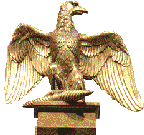






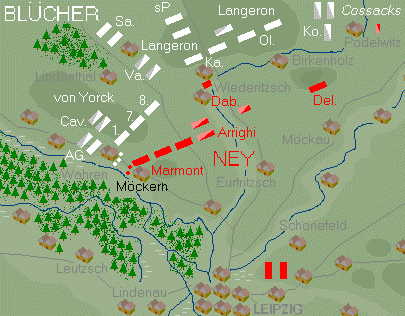 On map: deployment of troops
On map: deployment of troops

 Merveldt was given a letter to the Austrian Emperor (on picture) in which
Napoleon offered to surrender to the allies the fortresses he held along the Oder and Vistula, on the condition
that the allies allow him to withdraw to a position behind the Saale. He added that, if
approved, they should sign an armistice and undertake peace negotiations.
The offer was refused." (Nafziger - "Napoleon at Leipzig" p 191)
Merveldt was given a letter to the Austrian Emperor (on picture) in which
Napoleon offered to surrender to the allies the fortresses he held along the Oder and Vistula, on the condition
that the allies allow him to withdraw to a position behind the Saale. He added that, if
approved, they should sign an armistice and undertake peace negotiations.
The offer was refused." (Nafziger - "Napoleon at Leipzig" p 191)
